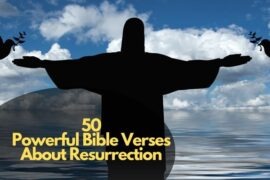It is crucial to understand that when the Bible talks about myths, it is not referring to legends or ancient stories in the way that we understand them today, but rather to deceptive beliefs and customs that are frequently passed down as tradition but are not based on God’s truth.
Read Bible verses about myths to understand more about myths in the Bible.
Contents
17 Bible verses about myths
The origin, traditions, reasons, practices, narratives, time, when, where; all of these and many more explain the word “myths” to provide the basis for religious beliefs.
Some myths exist as written texts, whereas in non-literate societies they exist as oral narratives.
These religious stories can be told in the form of art, music, and dance.
1 Timothy 4:7
Have nothing to do with irreverent, silly myths. Rather train yourself for godliness.-

In the same way that we call a paranoid myth an “old wives’ tale,” Paul is arguing a similar point here.
The assertions concerning God that Timothy needs to keep away from are “silly” unreliable misinformation that displeases God.
1Timothy 1:4
Don’t let them waste their time in endless discussion of myths and spiritual pedigrees. These things only lead to meaningless speculations, which don’t help people live a life of faith in God.-

The apostle Paul is issuing a stern warning against any made-up myth, superstition, conjecture, or fancy of the heart, all of which are exceedingly harmful to a Christian’s spiritual development, in opposition to biblical truth, and a hindrance to one’s hope in the Lord.
2 Peter 1:16
For we did not follow cleverly devised myths when we made known to you the power and coming of our Lord Jesus Christ, but we were eyewitnesses of his majesty.-

The preceding allusion indicates that Paul was familiar with Peter’s writings and that Peter was, in fact, an eyewitness to Jesus’ life, as he claimed.
In addition to Paul, Peter is another apostle who challenged legendary beliefs by presenting Jesus as the omnipotent God who is One with the Father and provides power for His blood-bought children’s everyday needs.
Peter also saw that the only way we may increase in grace and mature in our faith is by minimizing the importance of ourselves so that the power, majesty, dominion, and might of Christ may be manifest in us and elevated on high.
However, it also indicates that no citation or reference is required to remind us that “what comes from God lives eternally,” and we can have faith in God’s promises because God himself is trustworthy.
What do myths mean in Bible?
Myth refers to a traditional story, usually associated with the time of origins (e.g., creation or some important institution) that has paradigmatic significance for the society in which the story is operative
1 Titus 1:14
They must stop listening to Jewish myths and the commands of people who have turned away from the truth.-
Paul worries about advice from people who have rejected the truth.
Some people had embraced the fraudulent teachers’ beliefs and taken their comments at face value.
Paul asks Titus to reprimand these individuals severely in order to put an end to this issue right away.
Bible fables
Bible Fables are feigned stories or tales, intended to instruct or amuse; a fictitious narration intended to enforce some useful truth or precept.
Jotham’s fable of the trees is the oldest extant, and as beautiful as any made since.
1. Fiction in general; as the story is all a fable.
2. An idle story; vicious or vulgar fiction.
3. But refuse profane and old wife’s fables. Look at 1 Timothy 4.
4. The plot, or connected series of events, in an epic or dramatic poem.
The moral is the first business of the poet; this being formed, he contrives such a design or fable as may be most suitable to the moral.
5. Falsehood; is a softer term for a lie.
Genealogies
A genealogy is a record of family lineage, like a family tree where you have the father as the origin.
It documents a family’s background and serves as a valuable historical and legal instrument.
The general interest in genealogies in our modern world should signal the use of such records.
Historically, people have attached great value to family lineages, including those in scripture.
Here are some general facts regarding biblical genealogies.
- Genealogies for the most part trace family histories through males.
- The relationships frequently are father-son connections, though this is not the case always.
- The genealogies of scripture had both material and spiritual values.
The genealogy of Jesus is an account of Matthew and Luke’s gospel.
Matthew starts with Abraham while Luke begins with Adam.
Matthew 1:1-25
The book of the genealogy of Jesus Christ, the son of David, the son of Abraham. Abraham was the father of Isaac, and Isaac the father of Jacob, and Jacob the father of Judah and his brothers, and Judah the father of Perez and Zerah by Tamar, and Perez the father of Hezron, and Hezron the father of Ram, and Ram the father of Amminadab, and Amminadab the father of Nahshon, and Nahshon the father of Salmon, and Salmon the father of Boaz by Rahab, and Boaz the father of Obed by Ruth, and Obed the father of Jesse, …
Greek mythology in the bible
Myths in the Bible
Believers in the Bible do not believe in myths because the Bible warns against them.
The Bible writers were not ignorant of mythology—they were against it.
The ancient world had many myths, just as it had astrologers and mediums, necromancers, and religious temples.
The Bible was adamantly opposed to them all. The word “myth” occurs five times in the New Testament. On each occasion it is negative.
What does the Bible say about mythical creatures?
The Bible only confirms the existence of real animals and not mythical creatures.
In the bible, Paul together with some other apostles warns believers to shy away from mythical beliefs and should listen to whosoever preaches about them.
Mythical creatures mentioned in the bible tend to be a new introduction that occurs as a result of a mistranslation of the bible.
An example is this mistranslation is the ‘unicorn’.
Because we forget that a single horn is a typical element on God’s menu for animal design, modern readers struggle with the unicorns in the Bible. (Consider the narwhal and rhinoceros.)
According to Psalm 29:6, unicorns travel like bullocks, skip like calves, and bleed when they die (Isaiah 34:7).
It is meant for readers to picture strength when they see this robust, independent-minded creature because it has a very powerful horn.
There is absolutely nothing regarding unicorns in the Old Testament’s original Hebrew text, though.
Only the King James Version makes reference to unicorns because of a nearly 2,200-year-old error that originated in the Greek Septuagint.
The majority of contemporary Bible translations have fixed this error.
ox” and not “unicorn” or “one-horn.”
The Cockatrice
This creature is mentioned several times in the KJV’s translations of the books of the prophets.
Jeremiah 8:17 reads, “For, behold, I will send serpents, cockatrices, among you, which will not be charmed, and they shall bite you, saith the Lord.
” Isaiah 11:8 says, “And the sucking child shall play on the hole of the asp, and the weaned child shall put his hand on the cockatrice’ den.” Long says of this creature, “The prophet Isaiah informs us that a cockatrice, a mythical creature able to kill its victim with a casual glance, will arise from a serpent (Isa. 14:29).
What tangible evidence do we have to believe that a creature with this incredible ability has ever existed?”4
But Long is mistaken in his description because Isaiah never mentions the “cockatrice” nor does he describe this creature as having supernatural powers.
Like the King James Bible in whose pages it is found, the cockatrice is a product of medieval European thinking and would have been unknown to prophets like Jeremiah or Isaiah.
According to English scholar Laurence Breiner, “The cockatrice, which no one ever saw, was born by accident toward the end of the twelfth century and died in the middle of the seventeenth.”5
Although allusions to the creature can be traced back to Pliny the Elder, the dissident Catholic John Wycliffe first used the term “cockatrice” in 1382 in his popular translation of the Bible.
It was later used in the 1535 Coverdale Bible, which may have been the source for the KJV’s use of this word.
While Isaiah and Jeremiah would have been unaware of the “cockatrice,” they would have known what a tsepha‘ was.
This is the original Hebrew word used in passages like Isaiah 11:8 and it simply means “snake” or “viper.”
Today, most modern translations render passages like Isaiah 11:8 in this way, “the weaned child shall put his hand on the adder’s den [an adder is a kind of venomous snake].”
The Bible is not a mythical book,” but it does contain references to stories or accounts that may be considered myths by some people.
In the Bible, the word “myth” is not used in the modern sense of a story that is not true or that is based on legend or tradition.
Instead, the word is used to refer to stories or accounts that convey a deeper meaning or truth, even if they are not literally true.
For example, the Bible contains numerous parables, which are stories that Jesus used to teach spiritual truths.
These parables are not meant to be taken literally, but rather as illustrations to help people understand deeper truths about God and his relationship with humanity.
The Bible also contains accounts of events that some people may consider myths, such as the creation of the world, the flood, and the resurrection of Jesus.
While these events are not literally true in the same way that historical events are true, they are considered by many people to be true in a deeper sense, as they are believed to convey important spiritual truths about God and his relationship with humanity.








